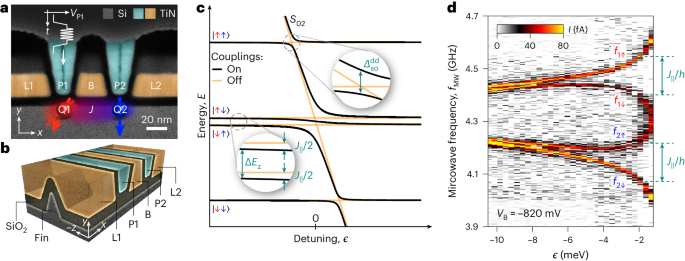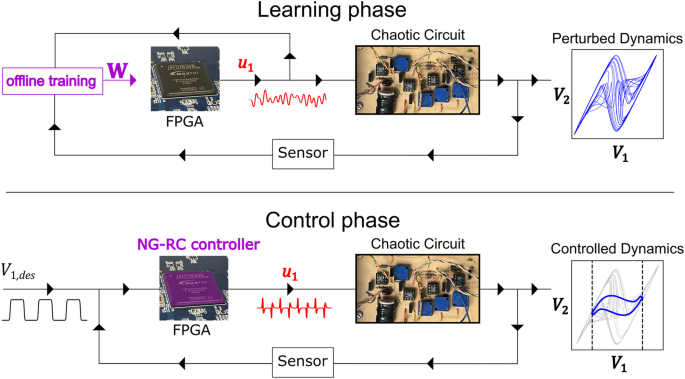2024-05-06 スイス連邦・バーゼル大学

・ バーゼル大学とスイス連邦研究能力センター(NCCR) SPIN が、シリコンを使用した従来の FinFETs(フィン型電界効果トランジスタ)で、2 個の正孔(ホール)スピン量子ビットの相互作用を電気的に制御することに初めて成功。
・ 同大学は、2022 年に FinFETs 内の正孔スピンを捕捉して量子ビットとして使用できることを実証。量子コンピューターの基盤となる量子ビットが正しく機能するには、情報の確実な保存と迅速な処理の両方が不可欠。高速情報処理の基礎を成すものは無数の量子ビット間の安定した高速相互作用だが、その状態を外部から確実に制御できることが重要となる。
・ 量子コンピューターの実用化には、1 つのチップに数百万個の量子ビットを搭載する必要がある。現在最先端の量子コンピューターに搭載されている量子ビットは僅か数百個で、従来のコンピューターの演算能力と同等となっている。
・ 電子と正孔はそれぞれがスピンを有し、古典的なビットの 0 と 1 のように、上向きか下向きの 2 通りの状態を取ることができる。正孔のスピンには、チップ上に微小磁石等の部品を追加せずとも完全に電気的に制御できるという利点がある。「量子ゲート」は、量子コンピューターでの計算の実行に不可欠なもの。
・ 本研究では、2 個の量子ビットを連結させ、一方のスピンの状態によるもう一方のスピンの反転の制御(スピンフリップ)に成功。正孔スピンによる高速・高忠実度の 2 量子ビットゲートを実証した。この原理は、さらに多数の量子ビットのペアの連結も可能にする。
・ 2 個のスピン量子ビットの連結は、静電的に相互作用する区別不能な 2 個の粒子間に起こる交換相互作用に基づくもの。正孔の交換エネルギーは電気的に制御可能なことに加え、強力な異方性を有する。これは、正孔のスピン状態が空間でのその運動に左右されるという、スピン-軌道相互作用によるもの。
・ 正孔スピンによる量子ビットは、実証済みのシリコンチップの製造技術を利用できるだけでなく、高度にスケーラブルで高速・堅牢であることが実験により証明されている。このアプローチは、大規模な量子コンピューターの開発競争をリードする可能性の高さを示している。
・ 本研究は、 NCCR SPIN、Swiss NSF、EU H2020 European Microkelvin Platform EMP が支援した。
URL: https://www.unibas.ch/en/News-Events/News/Uni-Research/Experiment-opens-door-for-millions-of-qubits-on-one-chip.html
<NEDO海外技術情報より>
関連情報
Nature Physics 掲載論文(フルテキスト)
Anisotropic exchange interaction of two hole-spin qubits
URL: https://www.nature.com/articles/s41567-024-02481-5
Abstract
Semiconductor spin qubits offer the potential to employ industrial transistor technology to produce large-scale quantum computers. Silicon hole spin qubits benefit from fast all-electrical qubit control and sweet spots to counteract charge and nuclear spin noise. However, the demonstration of a two-qubit interaction has remained an open challenge. One missing factor is an understanding of the exchange coupling in the presence of a strong spin–orbit interaction. Here we study two hole-spin qubits in a silicon fin field-effect transistor, the workhorse device of today’s semiconductor industry. We demonstrate electrical tunability of the exchange splitting from above 500 MHz to close-to-off and perform a conditional spin-flip in 24 ns. The exchange is anisotropic because of the spin–orbit interaction. Upon tunnelling from one quantum dot to the other, the spin is rotated by almost 180 degrees. The exchange Hamiltonian no longer has the Heisenberg form and can be engineered such that it enables two-qubit controlled rotation gates without a trade-off between speed and fidelity. This ideal behaviour applies over a wide range of magnetic field orientations, rendering the concept robust with respect to variations from qubit to qubit, indicating that it is a suitable approach for realizing a large-scale quantum computer.



